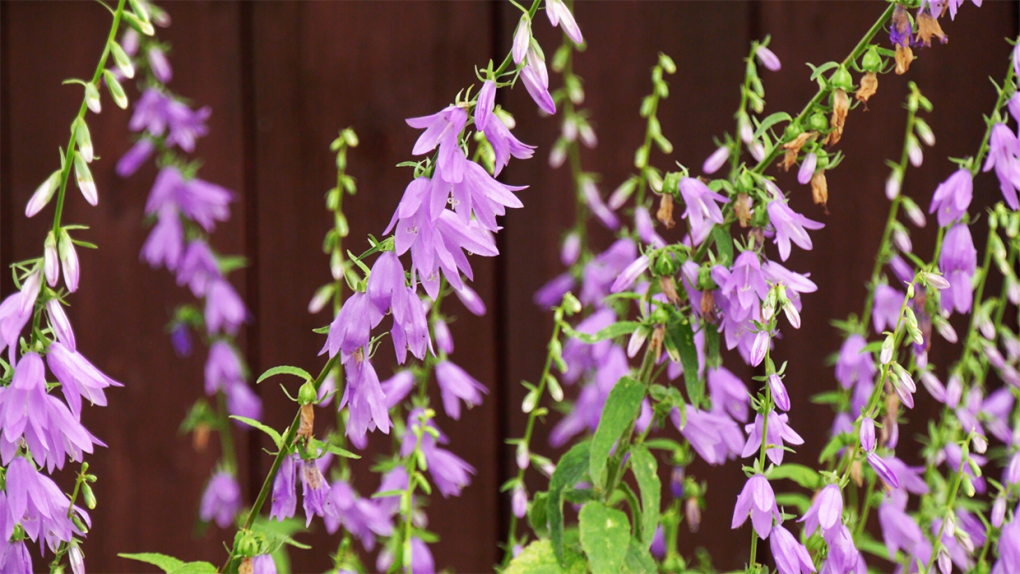Seek and destroy: Beware the creeping bellflower, the attractive and invasive garden guest you can't get rid of
The creeping bellflower plant can take over yards and suck the life out of more desirable plants in a short period of time because it is extremely invasive. It’s now blooming and about to seed. Horticulturalist John Ostrowdun says now is a good time to get the word out to all Calgarians – gardeners and non-gardeners alike.
Ostrowdun says the plant's pretty appearance may trick some into believe it is harmless, “People give it to their friends, because it's a beautiful perennial, which is why it spreads as fast as it does. And once you get it, it's quite hard to get rid of.”
According to Ostrowdun once you have creeping bellflower in your garden, getting rid of it may not be easy, “It's a lot of manual labor, a lot of chemical treatment, and then just keeping up on it," he said. "I know in my own yard, when I first bought my house it took me a good five years of hard work to get it, where it's now manageable. It still pops up once in a while, I still periodically find it in my yard and I just remove it right away when I see it.”
Creeping Bellflower or campanula rapunculoides is a low-growing clumped foliage in spring and grows to one metre tall flowering spike in early summer. The plant's leaves are heart-shaped in early stage and become more lance-shaped, tooth-edged and coarse textured as they mature.
 Creeping bellflower, July 21, 2021
Creeping bellflower, July 21, 2021
The flowers are purple-blue, two-to-three centimetres long nodding bells and blooms begin on the plants lower stem.
According to the city of Calgary pest management website,” Once established, creeping bellflower is very difficult to remove as even the smallest tiny root fragments can grow entirely new plants. It also spreads very easily as each stem produces up to 15,000 seeds. Creeping bellflower is also resistant to some herbicides.
Creeping bellflower is also known as garden bluebell, rover bellflower, purple bell, garden harebell, creeping campanula, creeping bluebell.”
Ostrowdun said if you enjoy the look of this plant but not the way it's been taking over your yard, you do have some alternatives to consider, “(There are) some campanula that aren't as aggressive but look like this, things like delphiniums work really well, penstemons work really well, if you like that same look.” So there are quite a few options you can use in the garden to replace that plant that you may enjoy.
CTVNews.ca Top Stories

LIVE NOW Budget 2024 prioritizes housing while taxing highest earners, deficit projected at $39.8B
In an effort to level the playing field for young people, in the 2024 federal budget, the government is targeting Canada's highest earners with new taxes in order to help offset billions in new spending to enhance the country's housing supply and social supports.
BUDGET 2024 Feds cutting 5,000 public service jobs, looking to turn underused buildings into housing
Five thousand public service jobs will be cut over the next four years, while underused federal office buildings, Canada Post properties and the National Defence Medical Centre in Ottawa could be turned into new housing units, as the federal government looks to find billions of dollars in savings and boost the country's housing portfolio.
Some of the winners and losers in the 2024 federal budget
With a variety of fiscal and policy measures announced in the federal budget, winners include small businesses and fintech companies while losers include the tobacco industry and Canadian pension funds.
From housing initiatives to a disability benefit, how the federal budget impacts you
From plans to boost new housing stock, encourage small businesses, and increase taxes on Canada’s top-earners, CTVNews.ca has sifted through the 416-page budget to find out what will make the biggest difference to your pocketbook.
Liberals aim to hit the brakes on car theft with new criminal offences
The Liberals are proposing new charges for the use of violence while stealing a vehicle and for links to organized crime, as well as laundering money for the benefit of a criminal organization.
Police to announce arrests in Toronto Pearson airport gold heist
Police say that arrests have been made in connection with a $20-million gold heist at Toronto Pearson International Airport one year ago.
Teen hockey players arrested for sexual assault following hazing incident: Manitoba RCMP
Three teenagers were arrested in connection with a pair of alleged hazing incidents on a Manitoba hockey team, police say.
Feds offer $5B in Indigenous loan guarantees, fall $420B short on infrastructure asks
The federal government is providing up to $5 billion in loan guarantees to help Indigenous communities invest in natural resource and energy products. But when it comes to a promise to close what advocates say is a sprawling Indigenous infrastructure gap, Ottawa is short more than $420 billion.
BUDGET 2024 Ottawa police get $50 million to boost security around Parliamentary Precinct
The Ottawa Police Service will receive $50 million in new federal funding over the next five years to "enhance security" around the Parliamentary Precinct.
































